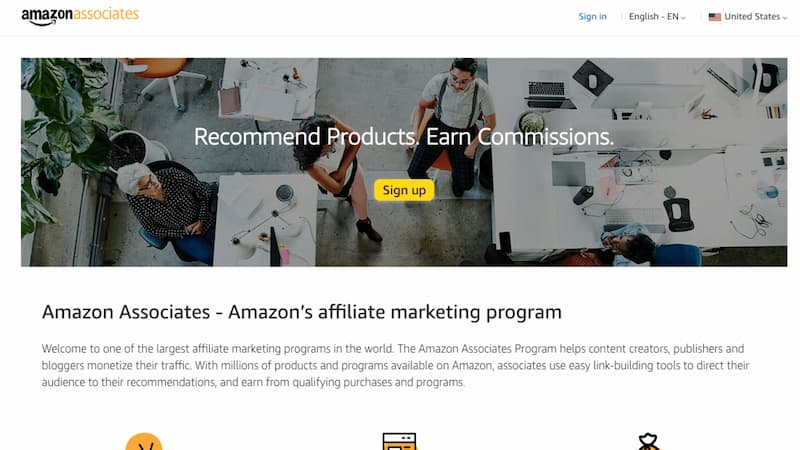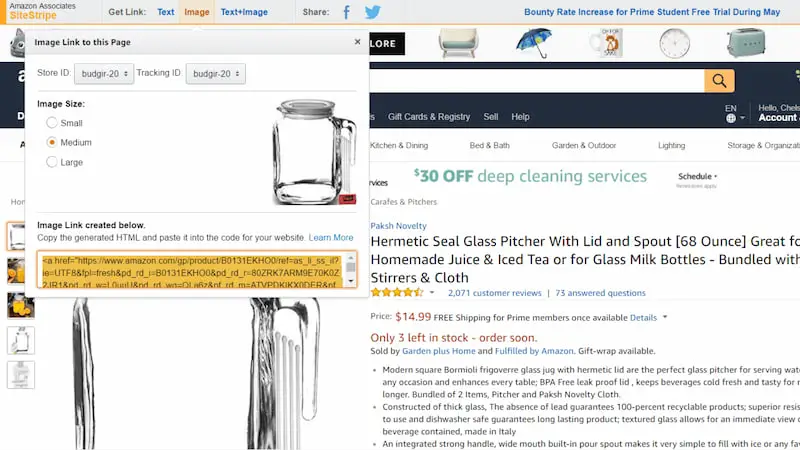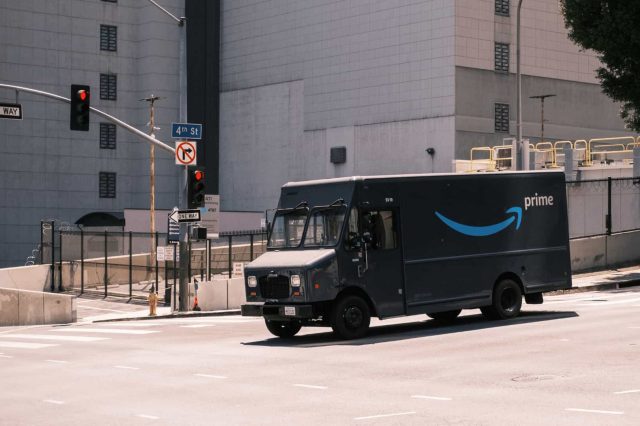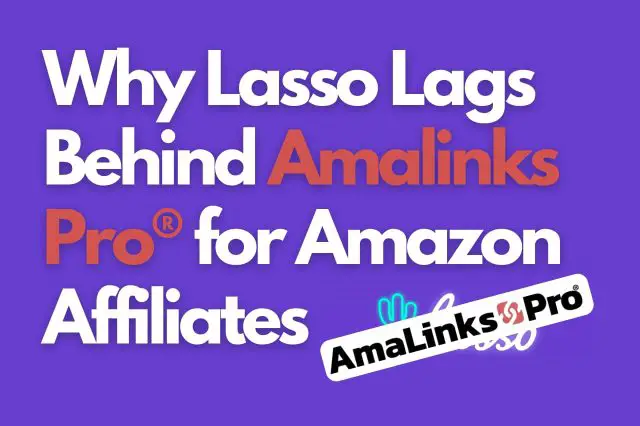The Amazon Affiliate Program is one of the largest and most trustworthy affiliate programs online – but it isn’t without its hiccups.
If you’ve ever tried promoting Amazon products through the program, you may have run into some puzzling issues regarding your affiliate links.
For one, if you don’t properly format your Amazon Associates tag, it won’t ‘fire,’ and you won’t receive credit for your commission. That can be incredibly frustrating, especially if you did your due diligence and generated many sales through your promotional efforts.
Then there’s the geographic issue that has long plagued the program.
If you use a US-based Amazon link for customers in the UK, they won’t be able to buy your products unless you set up and utilize a link localization solution. That can be a significant issue if you rely on an international audience.
The solution?
The Amazon Affiliate Link Generator below will provide you with correctly formatted links for any product – ensuring that you ALWAYS get credit for your sales – international or otherwise.
Also, it always helps to know how to properly generate affiliate links for your products, which is why we’ve put together five easy steps to do so.
Read on to learn how to quickly generate an Amazon affiliate link for any product on the website. Along the way, we’ll address commonly asked questions about Amazon Associates links.
Which Section Do You Want to Read First?
- Sign up for an Amazon Affiliate Account & Get Approved
- Login to Your Amazon Associates Dashboard
- Find Your Unique Affiliate Code
- Find the ASIN of the Product You Want to Promote
- Generate a Link within the Amazon Associates Dashboard: Site Stripe
- Bonus Step: Use AmaLinks Pro® to Increase Your Sales & Commissions
- AmaLinks Pro® Pricing Plans to Fit Any Need
- FAQs for Generating an Amazon Affiliate Link
- Demo AmaLinks Pro®: Core Features Increase Commissions
Sign up for an Amazon Affiliate Account & Get Approved
The first step is to sign up for the Amazon Associates Program and get approved for the program. To sign up, you’ll need a regular account on Amazon.com. If you don’t have one already, you can sign up for one here.
After that’s done, it’s time to create an account on Amazon Associates.
Note: If you’re not based in the United States, you can view our list of countries that have Amazon Associates programs here (including links to signup).
There are a few steps here, including:
- Confirming your account address to receive payments
- Entering all your websites and mobile apps you plan to use with the program (you’ll need to enter the full URL along with the protocol HTTP or HTTPS)
- Personal information for your profile
Once you’ve completed these steps, you can start using Amazon Associates Central. Yet, you won’t officially become an Associate until your application gets approved.
Besides ensuring you fall within Amazon’s operating policies, you also need to generate three sales within your first 180 days. Only then will you receive approval and become an official Amazon Associate.
Login to Your Amazon Associates Dashboard

Once you’re approved, you’ll be able to log in and view your Amazon Associates dashboard.
At the top of the screen, you’ll see the following options:
- Home
- Product Linking
- Widgets
- Tools
- Reports
- Help
The ‘Product Linking’ tab is one of the most common ways to generate an affiliate link, and we’ll go into more detail on that in a bit. Using Amazon’s Site Stripe tool is the other very common way to easily create Amazon affiliate links.
Besides that, you can access any widgets that you want to use on your websites.
Amazon Associates offers several of these, such as the Amazon Search Widget. It enables you to include an Amazon search bar directly on your website, which can encourage customers to continue shopping so you can earn more commissions.
You’ll also get to view detailed performance analytics via the ‘Reports’ tab. There are detailed breakdowns of your revenue, earnings, traffic, link types, and conversion rates to help you monitor your success as well as identify areas for improvement.
Find Your Unique Affiliate Code
Next, you’ll need to find your unique affiliate code or Amazon Associates Tag. It’s the unique identifier that Amazon will use to contribute sales to your account, and you need to add it to the end of every affiliate link.
Where do you find this tag?
It’s located in the top-right corner of the dashboard homepage next to Store, and it will always end in a -20. An example would look like this:
Store: your website-20
Your main ‘Store’ tag can be used as your affiliate Tracking ID – but most affiliates choose to create additional/multiple Tracking ID’s. The purpose of using multiple Tracking ID’s is that you can track your sales across different websites/pages or platforms.
For example: you might have a blog and a YouTube channel and you might want to track which sales come from each.
Sign Up for Our Free Amazon Affiliate Masterclass

There’s a lot to know when you become an Amazon Associate, and it may seem overwhelming at first. Adding to that pressure is the fact that you must land three sales within 180 days of signing up to gain official entry into the program.
That can be a challenging task for beginners, especially if you aren’t familiar with the ins and outs of Amazon’s affiliate program.
To thank you for visiting our website, we’d like to offer utterly free signup for our Amazon Affiliate Masterclass – part of our Level Up Series.
The course breaks down everything you need to know about Amazon Associates, including insider tips and tricks that you won’t find anywhere else. You’ll learn how to leverage every tool at your disposal to promote products through the program successfully – as well as how to keep your account safe and protected.
Find the ASIN of the Product You Want to Promote
The next step is to find the ASIN or Amazon Standard Identification Number for the product you want to promote.
It’s usually pretty easy to find a product’s ASIN, as it’s almost always listed under the Product Details section.
It’s usually listed under Domestic Shipping and International Shipping. The ASIN system is how Amazon keeps track of every product in its inventory.
Important note: If you’re promoting a book, you may not find an ASIN for it on Amazon outright. Instead, you’ll need to use its ISBN-10 (International Standard Book Number), which doubles as its ASIN.
Besides looking at the product page, there’s another way you can identify the ASIN for a product – by finding it in the URL.
Every Amazon product URL includes the ASIN right before the referral code. Here’s an example:
The ASIN is the 10-digit string of numbers and letters that comes right before the ‘ref=’ section. In this case, the ASIN is B01M318FRC.
Generate a Link within the Amazon Associates Dashboard: Site Stripe

An expedited way to generate an affiliate link is to use SiteStripe – Amazon’s built-in Associates’ toolbar. With it, you can generate links straight from
Amazon’s product pages without having to visit Associates Central.
To enable SiteStripe, go to Tools > SiteStripe > Learn More. From there, you can enable it under Display Settings.
On the SiteStripe dashboard, you’ll see three options:
- Text
- Image
- Text + Image
These options refer to the types of links you can generate with SiteStripe. You can create basic text links, image links, and a text link with an image.
All you need to do is click on one of the options to generate a link that you can copy and paste on your website.
You’ll even have the option of generating a short link or a full link. The conciseness of short links is perfect for social media posts, as it’s easier for users to copy them. Full links are better for long-form blog posts, as they’re easier to edit.
Your Tracking ID is automatically added to the link, so you don’t have to worry about it (you can select which Tracking ID you would like to use right from the SiteStripe toolbar).
Bonus Step: Use AmaLinks Pro® to Increase Your Sales & Commissions
By now, you know how to become your own Amazon affiliate link generator. You can use our tool, SiteStripe, or choose to create the links yourself.
Yet, generating links is one thing, but being able to earn commissions off those links is another thing entirely.
To give your affiliate marketing efforts a serious boost, you need to use AmaLinks Pro® on your WordPress website. Our WordPress plugin allows you to create stunning product showcases, engaging comparison tables, CTA buttons, and more.
Beyond that, we’re the only Amazon plugin that has a No-API mode. As mentioned previously, you need to land three sales before you become an official Amazon Associate that has access to the Amazon Product Advertising API.
That’s quite the challenge if you have no affiliate marketing experience.
What’s worse is that every other plugin on the market requires you to already have access to the Amazon API to use them.
AmaLinks Pro® features a comprehensive No-API mode where you can still create product showcases, comparison tables, and CTAs. That will help you land your first three sales so you can gain access to the API and start cooking with gas.
AmaLinks Pro® Pricing Plans to Fit Any Need

Alt tag: The AmaLinks Pro® Pricing guarantee.
AmaLinks Pro® features flexible pricing that’s suitable for all budget levels. From stay-at-home bloggers earning extra income to enterprises, our plans have all the bases covered.
Each plan gains access to our core features, showcase boxes, comparison tables, and regular support.
Our plans offer different tiers, each with various features, priority support, and thousands of niche product ideas as a bonus – so don’t wait to sign up now.
FAQs for Generating an Amazon Affiliate Link
[rank_math_rich_snippet id=”s-2f83c671-9ab5-4562-83b1-51d371bf15a6″]
An example of an Amazon Affiliate Link
Now that you know how to generate an Amazon affiliate link let’s look at an example of one in action.
Here’s my properly formatted affiliate link for ‘Why Stuff Sucks: Volume 2’:
As you can see, I didn’t include the long referral code at the end. Instead, I added my Associates Tag directly after the ASIN – ?tag=milesanthonysmith-20. To me, this link is the perfect length to include on my website.
Demo AmaLinks Pro®: Core Features Increase Commissions

Alt tag: The AmaLinks Pro® logo.
AmaLinks Pro® is the #1 way to find success with Amazon Associates. No other plugin has a No-API mode that will help you land your first three sales.
Beyond that, every aspect of AmaLinks Pro® is set up to increase sales and conversions.
Core features include:
- Showcase boxes and comparison tables
- Amazon compliant images and descriptions straight from the API
- ‘Prime eligible’ badge for Prime products to increase sales
- Convincing CTA buttons
- Accurate prices updated in real-time
To see ALP in action, check out this exclusive demo.





